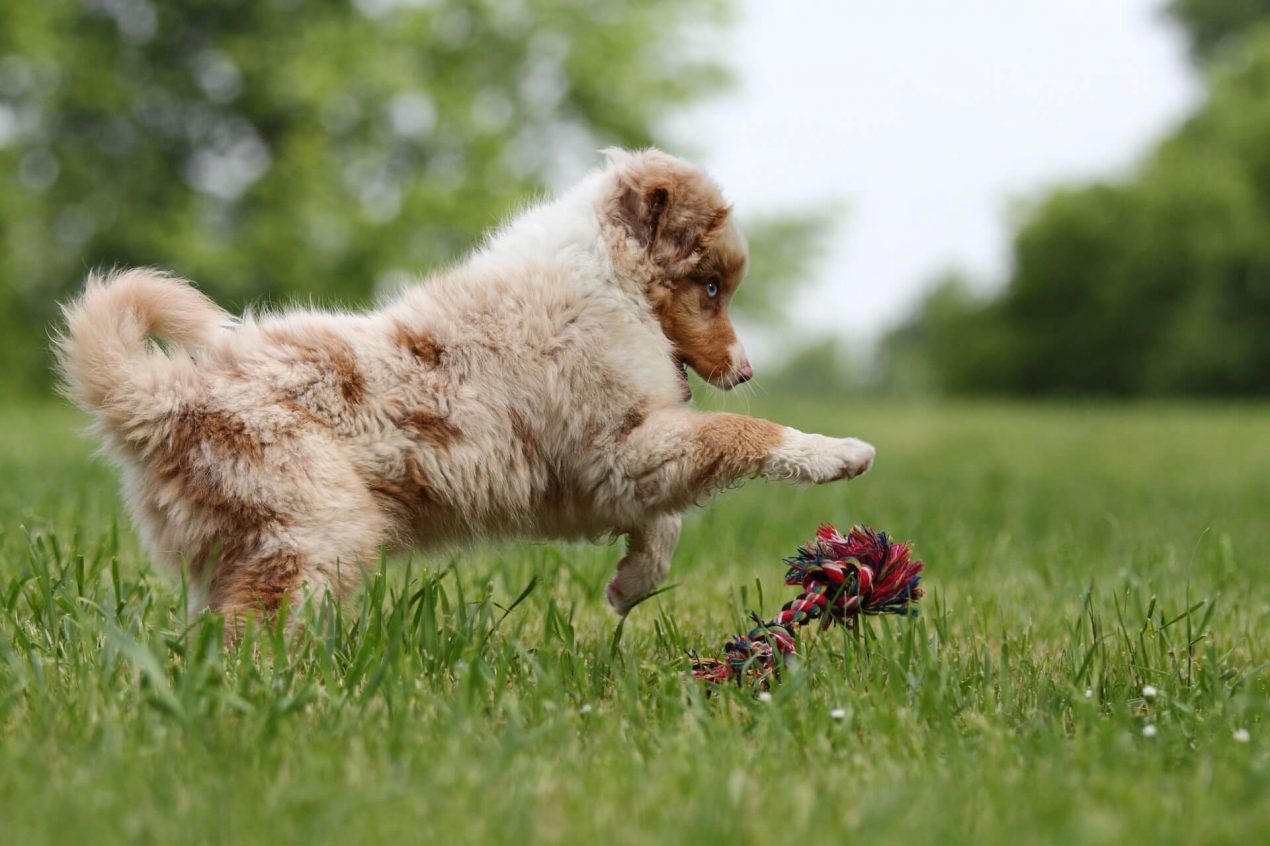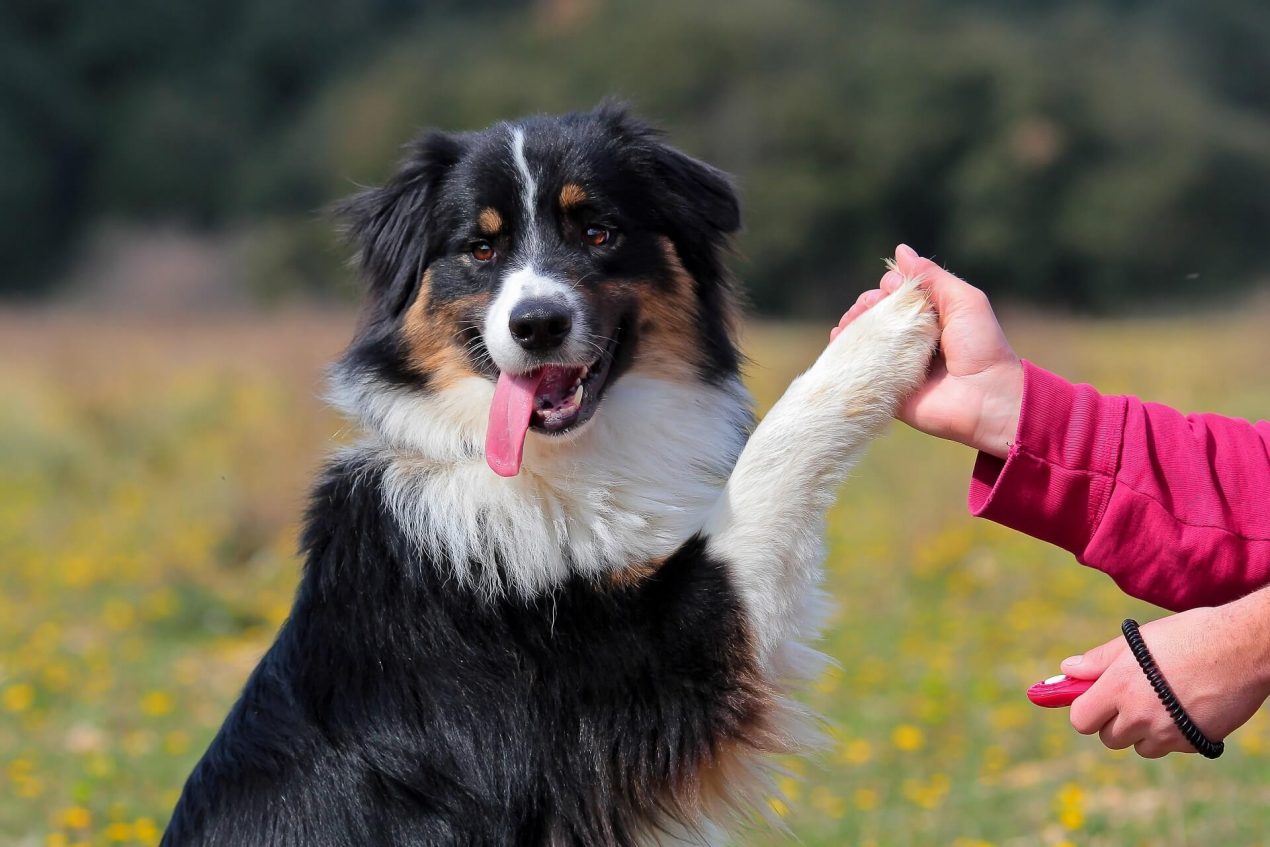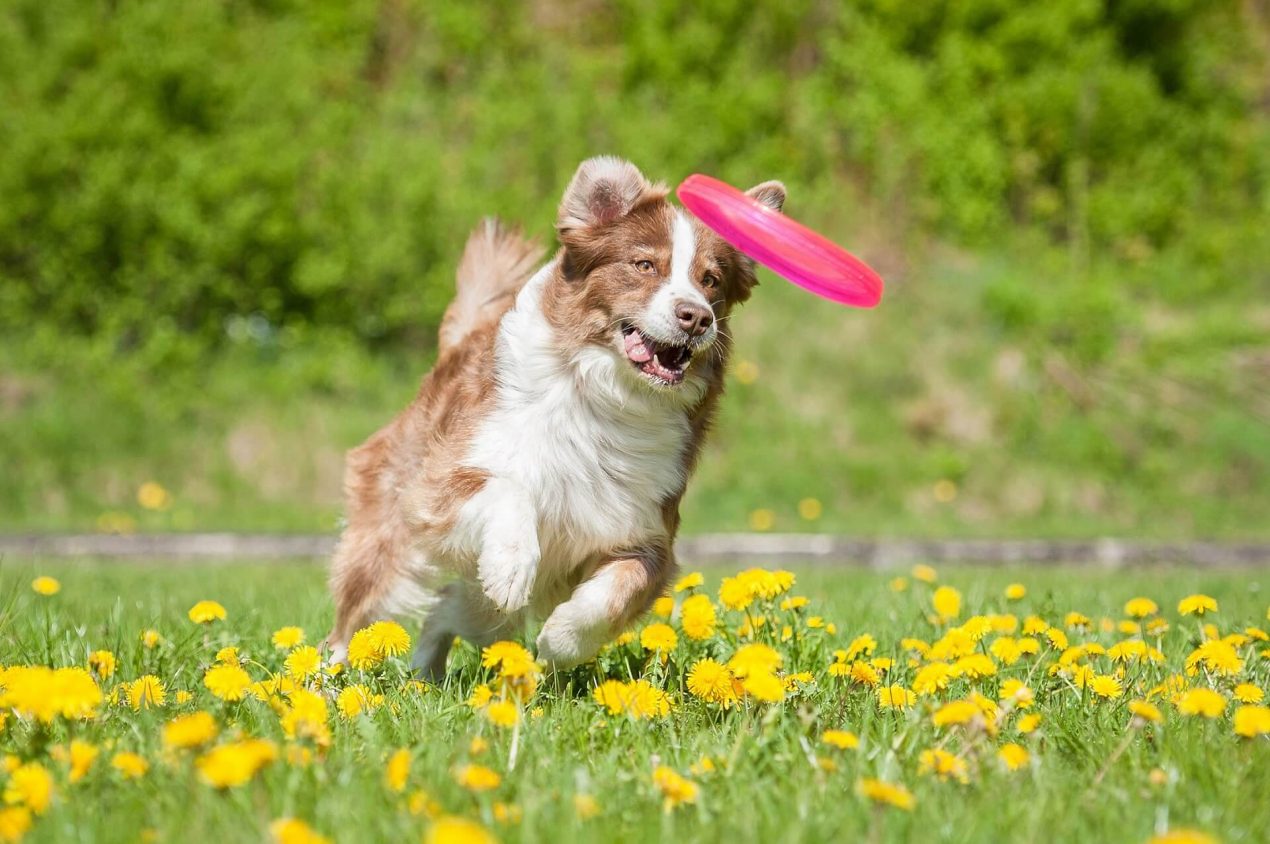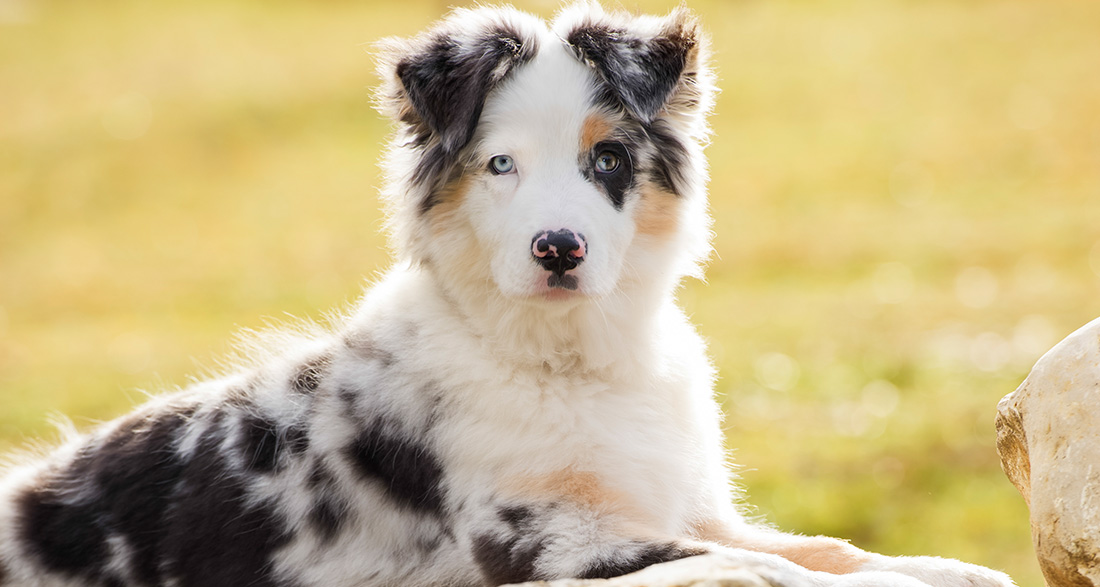If you’re looking for a faithful companion with a lively spirit and an impressive ability to tackle tasks, then the Australian Shepherd is the perfect dog for you. This versatile and intelligent dog will not only impress you with its eagerness to learn and energy but also with its deep bond to the family.
In the following sections, we’ll explore together how you can provide a happy and healthy life for your Aussie, which exercises will challenge them mentally, and how you can strengthen the bond with this unique four-legged friend. With valuable tips on training, grooming, and health, this article will be your guide to a fulfilling life with your Australian Shepherd.
- History of the Australian Shepherd
- Appearance of the Australian Shepherd
- Traits and Characteristics
- Acquiring an Australian Shepherd
- Development and Training of the Puppy
- How to Care for an Australian Shepherd?
- Health and Hereditary Diseases
- Care for the Australian Shepherd
- Nutrition and Diet
- Active Communities for Australian Shepherd Owners
- Interesting and Worth Knowing
History of the Australian Shepherd
When you hear the name Australian Shepherd, the assumption might be that the breed hails from Australia. However, contrary to its name, the Australian Shepherd originally comes from the United States. In the early 19th century, many immigrants from Europe and Australia brought livestock and herding dogs to the states. Versatile and reliable herding dogs were needed on the new American farms.
Farmers wanted a dog that could both manage the sheep and protect the farm. The Australian Shepherd was therefore bred as a watchdog. As many herding dogs arrived in the United States along with “Australian Sheep,” the theory emerged that the dogs were called “Australian Shepherds” because of this.
Australian Shepherds gained their first fame at rodeo shows in the 1950s and 60s. Farmer Jay Sisler from Idaho taught his Australian Shepherd remarkable tricks, captivating the audience with these beautiful dogs. Many wanted to own such an intelligent and beautiful dog themselves. The breed thus made the transition from a simple herding dog to a popular household pet. The Australian Shepherd Club of America was founded in Arizona in 1957.
However, the Australian Shepherd was officially recognized in 1991 by the AKC (American Kennel Club) and only in 1996 by the Fédération Cynologique Internationale (FCI). Along with the Border Collie and other herding dogs, the breed is classified into FCI Group 1, Section 1.
Breed Overview
GROUP: Herding
HEIGHT: 18 to 21 inches (female), 20 to 23 inches (male)
WEIGHT: 40 to 55 pounds (female), 50 to 65 pounds (male)
COAT: Medium double coat
COAT COLOR: Blue merle, red merle, black, or red; all colors may have white markings and/or tan (copper) points
LIFE SPAN: 12 to 15 years
TEMPERAMENT: Intelligent, active, energetic
HYPOALLERGENIC: No
ORIGIN: United States
Appearance of the Australian Shepherd
The Australian Shepherd is characterized by its medium-sized stature, strong muscles, and harmonious body proportions. Its coat is dense and of medium length, coming in various color variations.
The head of the Australian Shepherd is strong and proportional to the body. The ears are medium-sized and set high, often semi-erect or fully erect. The eyes are almond-shaped and can come in various colors such as blue, brown, or amber.
An outstanding feature of the Australian Shepherd is its bushy tail, which is often naturally shorter. The legs of the Australian Shepherd are muscular and well-developed, giving it impressive agility.
The coat of the Australian Shepherd is dense and of medium length, with a weather-resistant surface. It can be smooth or slightly wavy. Color variations range from black, blue, red to various combinations of white and tan.
| Affection Level | Medium |
| Friendliness | Medium |
| Kid-Friendly | High |
| Pet-Friendly | Medium |
| Exercise Needs | High |
| Playfulness | High |
| Energy Level | High |
| Trainability | High |
| Intelligence | High |
| Tendency to Bark | Medium |
| Amount of Shedding | Medium |
Traits and Characteristics
The Australian Shepherd (or Aussie) is an intelligent and enduring dog that can work with concentration for extended periods. The breed has a balanced nature and is friendly and loyal to its owner but can also be stubborn at times. Are Aussies sensitive? With strangers, the Aussie is sensitive and needs time to warm up. Additionally, they have a pronounced guarding instinct and protect their family. Due to their former use as herding dogs, they have keen observation skills and often decide for themselves what needs to be done.
Many wonder, is an Australian Shepherd suitable for beginners? The intelligent four-legged companion needs a meaningful task that they enjoy doing independently and diligently, so they are not recommended for beginners. When bored, they will seek out tasks themselves, which may not align with the owner’s expectations.
Are Aussies difficult to train? The Australian Shepherd is very eager to learn and therefore can be trained well. However, they tolerate no inconsistency from their owner. They get along well with other pets but tend to herd everything that moves due to their strong herding instinct. Joggers, cars, or playing children can stimulate this herding instinct. If not stimulated, Australian Shepherds often lean towards a hunting instinct.
They are very loyal to their humans and prefer to be with them always and everywhere. In general, it can be said that the Aussie is a great all-around farm dog that needs versatile challenges and plenty of exercise.
Acquiring an Australian Shepherd
The Australian Shepherd is by no means a dog for everyone. Anyone looking to buy a Shepherd puppy should be aware that the dog has a life expectancy of 13 to 15 years. During this time, you must engage and challenge the four-legged friend properly to ensure a happy coexistence. This also means that the demanding companion cannot be left alone at home all day. Additionally, you should be aware that with a size of nearly 55 cm, the dog is not very small and may not have enough space in a small city apartment.
The purchase price of an Australian Shepherd can vary greatly depending on where you buy the dog. For a puppy from a reputable breeder, you should expect prices around $1000. If you adopt a dog from a shelter or rescue an adult dog from a crisis, you will save a lot of money.
Australian Shepherds come in four basic colors: Blue Merle, Red Merle, Black, and Red, as well as 12 other variants. The eyes of Aussies vary greatly in color and can be brown, blue, green, yellow, or amber. Some dogs even have eyes of different colors.

Development and Training of the Puppy
When your Australian Shepherd puppies reach the age of 6-12 months, you will clearly feel their increasing energy and zest for action. In this phase, they reach sexual maturity. Australian Shepherds are considered late bloomers and are often not fully grown until 3-4 years old. Therefore, it is especially important during this time to provide them with sufficient stimulation and apply consistent obedience training. Teach your dogs early on that there are also times of rest. Otherwise, they may grow into dogs that constantly want to be in motion and are difficult to calm down.
Since Aussies are very intelligent and learn through observation, be careful not to demonstrate any unwanted behaviors. Be consistent in training, as these dogs seize every opportunity to learn from mistakes. Clicker training can be an effective method here to establish desired behavior with positive reinforcement.
Training with the Australian Shepherd
When training your Australian Shepherd, start early to establish a good foundation. These dogs are not only trainable and attentive but also sensitive and independent. They require clear and consistent leadership paired with plenty of praise and rewards. Use their curiosity and motivation to teach them new commands and tricks. They love learning and working and are capable of remembering a variety of tasks.
Provide your dog with enough variety and challenges to stimulate them mentally. Monotonous or repetitive exercises should be avoided as they can quickly lead to boredom and unwanted behaviors. Various search and sniffing games or intelligence toys are good ways to keep your Aussie’s mind busy.
Also, encourage your dog’s socialization and environmental adaptation. Positive experiences with different people, dogs, and environments are crucial for developing a confident and tolerant dog. Always consider the physical needs and limits of your Australian Shepherd. Plenty of exercise and stimulation are important, but so are sufficient periods of rest and relaxation to avoid overexertion and stress.
Recognize and promote your dog’s individual strengths and tailor the training to their personality. Set realistic goals and celebrate every progress. A positive and trusting learning atmosphere is essential for your Australian Shepherd to feel comfortable and secure. Approach them with kindness and understanding to build a strong bond and create an effective learning environment.

How to Care for an Australian Shepherd?
When choosing an Australian Shepherd, make sure they have plenty of space to live and allocate enough time for them. These dogs are full of energy, need lots of exercise, and are constantly seeking activities because their drive to work is innate.
They feel most comfortable when trained clearly and consistently. Not everyone can handle an Australian Shepherd, so they are better suited to experienced owners who give them tasks and physically and mentally challenge them.
While Australian Shepherds are resilient, they may be prone to certain hereditary diseases. Therefore, you should take them to the vet regularly and maintain a healthy lifestyle to keep your Aussie fit and healthy.
Activities with the Australian Shepherd
Australian Shepherds, or Aussies, are lively and intelligent dogs that require a daily mix of mental and physical activity. Bred originally as herding dogs, they have a strong work drive and high energy best channeled through varied activities.
Plan multiple walks daily, varying routes regularly to keep the environment exciting for your Aussie. Incorporate play breaks where you throw balls, sticks, or frisbees to promote the dog’s endurance. Aussies also enjoy accompanying you on jogs, hikes, or bike rides, showcasing their remarkable stamina.
For mental stimulation, various dog sports are suitable. Whether it’s agility, dog dance, obedience, or dog frisbee – your Aussie will enthusiastically participate. At home, intelligence toys ensure your dog is challenged, earning treats with paws and nose.
Herding is an activity that appeals to the Aussie’s natural instincts, promoting concentration and cooperation between you and your dog. Agility competitions, where the dog masters a course of various obstacles, and flyball, emphasizing speed and retrieving, are also ideal for this breed.
There are many competitions to participate in, such as ASCA Stockdog Trials, ISDS Trials, and AHBA Trials in herding, FCI Agility World Championship and ADAA National Grand Prix in agility, as well as NAFA CanAm Classic and EFL European Championships in flyball.
Don’t forget that even an energetic dog like the Aussie needs rest periods to recover and maintain balance. This ensures your four-legged friend remains content and balanced.

Health and Hereditary Diseases
Australian Shepherds are known for their robustness and longevity, with a life expectancy of 12 to 15 years. However, they are not free from genetic health risks. Hip dysplasia is one of the most common hereditary diseases in this breed. It leads to poor fit between the hip joint and socket, causing pain and movement restrictions. To minimize this condition, it is crucial for breeders to have their animals tested.
Additionally, Australian Shepherds may be affected by Progressive Retinal Atrophy (PRA), a degenerative retinal disease that can lead to vision loss. Epilepsy also presents a genetic risk, with seizures that can affect the quality of life. Besides these conditions, allergies, dermatitis, and cancer are other health problems they may encounter. Therefore, regular veterinary check-ups, a balanced diet, and sufficient exercise are essential.
In addition to hip dysplasia, various eye diseases such as cataracts and glaucoma are known, which should be detected early through regular checks. A rare but serious genetic condition is Multidrug Resistance 1 (MDR1), a gene mutation that impairs the processing of certain medications and can cause severe side effects. A genetic test can provide clarity here, and affected dogs should be appropriately marked.
Conducting health tests on breeding dogs is of great importance to reduce the spread of hereditary diseases and maintain the quality of the breed. These tests should be performed by qualified professionals, and the results should be made transparent. Responsible breeders who adhere to breeding standards play a key role in preserving the welfare of this wonderful breed.
Care for the Australian Shepherd
The Australian Shepherd is an easy-to-care-for dog with medium-length guard hair and a weather-resistant dense undercoat. His coat keeps him warm in winter and protects against sunburn in summer. Dust and dirt can be quickly removed by gentle brushing. For a shiny coat, it is sufficient to comb the Aussie vigorously once or twice a week. Under no circumstances should you shave the double coat, as this will damage the hair structure. Of course, you should also check and treat the ears, eyes, and paws daily as needed.
Nutrition and Diet
The Australian Shepherd is a high-energy dog and requires a balanced diet to stay active and healthy. His nutritional needs vary depending on age, weight, and activity level. Therefore, you should educate yourself about his nutritional needs and adjust the food accordingly.
Nutritional Needs of the Australian Shepherd
Your Australian Shepherd needs plenty of protein to strengthen his muscles and promote skin and hair health. Ensure that the proteins come from good animal sources such as meat, fish, eggs, or dairy products. Around 25 to 30 percent protein in the diet is ideal for your dog.
Fats are also important as they provide energy to the Australian Shepherd. Choose healthy fats from plants or animals, such as oils, nuts, or fish. These fats not only provide energy but also support skin and coat health. About 15 to 20 percent of the diet should consist of fats.
Carbohydrates are also an important source of energy for your dog. They should come from quality sources such as vegetables, fruits, or whole grains and make up about 30 to 40 percent of the diet. They also ensure good digestion.
Vitamins, minerals, and trace elements should not be missing from your Australian Shepherd’s diet. They keep him fit and support his organs. You can find these nutrients in natural sources such as fruits and vegetables. The exact amount depends on your dog and can be achieved through balanced food or supplements.
Adjusting Nutrition to Age and Activity Level
Always adjust the food to the age and activity level of your Australian Shepherd. This ensures that he has enough energy and maintains his weight. Puppies and young dogs need more energy because they are growing. Therefore, they should receive more proteins and fats and eat more frequently throughout the day. They should be fed about 3 to 5 percent of their body weight in food daily.
Adult and senior dogs need less energy and therefore less food. Feed them twice a day to control their weight and promote health. They require about 2 to 3 percent of their body weight in food per day.
Also, consider your dog’s activity level. Active dogs need more food to sustain their energy. Calmer dogs require less to avoid overweight. Active Australian Shepherds should receive about 3 to 4 percent of their body weight in food, while 1 to 2 percent is sufficient for quieter dogs.

Active Communities for Australian Shepherd Owners
The Australian Shepherd is at the heart of a dedicated community. Firstly, people here share their passion for breeding and caring for the breed. Additionally, they exchange knowledge and experiences, which enhances their enjoyment of these intelligent and energetic dogs.
Breed-specific clubs, communities, and events
Furthermore, there is a variety of clubs and groups dedicated to Australian Shepherds. For example, the Australian Shepherd Club of America (ASCA) advocates for high breeding standards and the health of the animals. Moreover, the Australian Shepherd Club of Europe (ASCE) consolidates interests at the European level. Particularly noteworthy is the Australian Shepherd World Championship (ASWC), where the crème de la crème is honored annually in various disciplines.
Exchange opportunities for owners and enthusiasts
There are numerous opportunities for breed enthusiasts to connect and share joy. Local meetings invite participants to share experiences in a relaxed atmosphere and let the dogs play uninhibitedly. Additionally, online groups and social media platforms offer the chance for lively exchange and quick information. Finally, Australian Shepherd blogs provide deep insights and report on experiences with these impressive animals.
Interesting and Worth Knowing
The most famous Australian Shepherds were Jay Sisler’s dogs Stub, Shorty, and Queenie, who even had their own television show called “Stub.” They also appeared in the two Disney films “Run Appaloosa Run” and “Stub: The Greatest Cowdog in the West.”
Another prominent Aussie was the Frisbee-catching dog Hyper Hank. In the 1970s, he performed at the Super Bowl and was even a guest at President Jimmy Carter’s White House.
Did you know?
- There are Australian Shepherds in miniature size too. The so-called Miniature American Shepherds are medium-sized dogs that have been recognized as a separate breed since 2019.
- Pairing two merle-colored dogs often results in deafness or blindness in the puppies and is prohibited in the United States.
- Some Aussies have a natural bobtail, also called “natural bobtail.” In the USA, dogs without tails are preferred as it allegedly reduces injuries during farm work.
Australian Shepherd Overview
Pros
- Personable
- Easy to Train
- Loyal
- Climate Adaptable
- Size
Cons
- High-Energy
- Shedding Fur
- Eye Issues
- Hip Dysplasia
Are you also big a fan of the Australian Shepherd? What do you think makes them so special? Tell us more in the comments down below!


